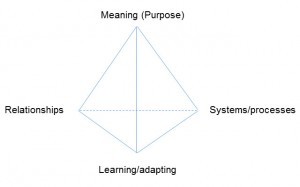A. Purpose:
To provide a basis for discussion – educating and providing feedback in the development of a healthy multi-stakeholder organisations. For in-depth questionnaire please click here……Questionnaire 140526aLocked
- For an introduction to the Questionnaire please see below.
- Once you click on the Questionnaire link
- Use the ‘Input’ tab to enter your ratings.
- Use the ‘Results’ tab to review input summaries.
- Use the ‘Definitions’ tab to check meaning of terms.
B. Key components:
There are many individuals and groups who have developed models and principles that address the concept of trust. However, as outlined below, we felt that there is no consensus on the concept of trust with and within organisations.
‘At present, there is no clear consensus on the concept of trust or trustworthiness at the organisational level, nor is there coherent theory, an agreed model or sufficient empirical research to guide a comprehensive understanding of organisational trust and how the latter might be linked to trust at more macro and micro levels. ’ Organisational Trust (Prof Reinhard Bachmann) Home page of website ‘organisationaltrust.org’
So, with some trepidation, we have identified what we feel is a good working definition of trust that can help to improve multi-stakeholder relationships.
1. Three useful trust-based reference points are:
· Transparency / openness (awareness, honesty, understanding)
· Consistency (stability, sustainability, reliability, integrity, responsibility)
· Mutual support (respect, difference, harmony, accountability, sense of community)
These are based on a review of the basic principles of eight organisations:
• IFAC Accountants (Sustainability Framework)
• Earth Charter
• Businesslink (Principles of Quality Management)
• B Corp (Assessment Summary – Manufacturing)
• Q&B Principles
• Worldblu – Principles
• ISO9000 (2008)
• Fourth Sector – Ecosystem
As the questionnaire evolves and becomes more robust it will be circulated more widely and additional performance improvement tools and materials will be developed to support the work. Even if these do not yet have the robustness of academic research they do provide an excellent way of looking at the organisation and seeing what is and isn’t supporting its effectiveness and sustainability.
2. Four key elements of an organisation:
· Purpose and objectives
· Key relationships
· Key systems and processes
· Ability to learn and adapt appropriately
Based on ideas developed in a number of sources with a focus on living systems. (‘Living Systems are organizationally closed – they are autopoietic networks – but materially and energetically open’. p11 The Hidden Connections) Particularly useful is the overview outlined by Fritjof Capra in ‘The Hidden Connections’.
He identifies four main perspectives in a tetrahedron which have then been adjusted for these purposes:
- Meaning/Purpose: ‘the perspective of Meaning is represented as lying outside the plane of this triangle to indicate that it opens up a new ‘inner’ dimension, so that the entire conceptual structure forms a tetrahedron.’ (P.64) this Meaning can be considered the organisation’s purpose and objectives.
- Relationships: a social network. ‘These networks of communications are self-generating. Each communication creates thoughts and meaning, which give rise to further communications, and thus the entire network generates itself – it is autopoietic. As communications recur in multiple feedback loops, they produce a shared system of beliefs, explanations and values – a common context of meaning – that is continually sustained by further communications. Through this shared context of meaning individuals acquire identities as members of the social network, and in this way the network generates its own boundary. It is not a physical boundary but a boundary of expectations, of confidentiality and loyalty, which is continually maintained and renegotiated by the network itself.’ (P 72)
- Systems and processes: allows the organisation to function. ‘A dissipative structure, as described by Prigogine, is an open system that maintains itself in a state far from equilibrium, yet is nevertheless stable: the same overall structure is maintained in spite of an ongoing flow and change of components. Prigogine chose the term ‘dissipative structures’ to emphasized this close interplay between structure on the one hand and flow and change (or dissipation) on the other.’ (p 12)
- Learning and adapting – essential to the organisation’s ability to self-generate. ‘ In other words, creativity – the generation of new forms – is a key property of all living systems. And since emergence is an integral part of the dynamics of open systems, we reach the important conclusion that open systems develop and evolve. Life constantly reaches out into novelty.’ (p12)
